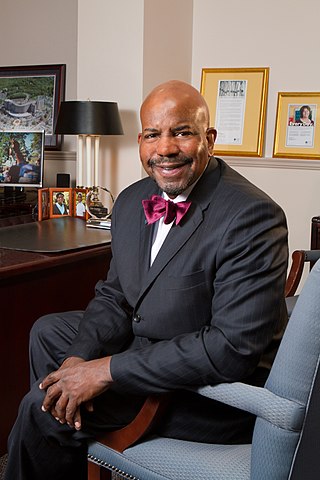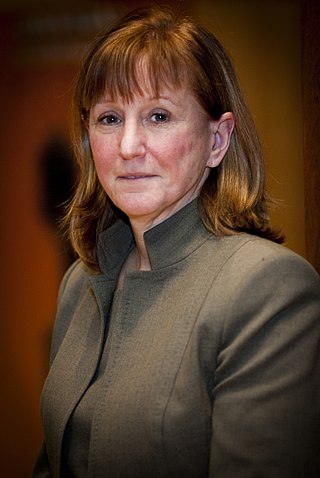Related Research Articles

Phelps County is a county in the central portion of the U.S. state of Missouri. As of the 2020 United States Census, the population was 44,638. The largest city and county seat is Rolla. The county was organized on November 13, 1857, and was named for U.S. Representative and Governor of Missouri John Smith Phelps.

Rolla is a city in, and the county seat of, Phelps County, Missouri, United States. Its population in the 2020 United States Census was 19,943. It is approximately midway between St. Louis and Springfield along I-44. Its micropolitan statistical area consists of Phelps County, Missouri.

Charles Stark "Doc" Draper was an American scientist and engineer, known as the "father of inertial navigation". He was the founder and director of the Massachusetts Institute of Technology's Instrumentation Laboratory, later renamed the Charles Stark Draper Laboratory, which made the Apollo Moon landings possible through the Apollo Guidance Computer it designed for NASA.

Robert Samuel Langer Jr. FREng is an American biotechnologist, businessman, chemical engineer, chemist, and inventor. He is one of the nine Institute Professors at the Massachusetts Institute of Technology.
Heraeus is a German technology group with a focus on precious and special metals, medical technology, quartz glass and sensors as well as electronic components. Founded in Hanau in 1851, the company is one of the largest family-owned companies in Germany in terms of revenue. Heraeus employs 16,400 people in 40 countries and generated a total revenue of €25.6 billion in 2023. The headquarters and head office are in Hanau, Germany.
Microparticles are particles between 0.1 and 100 μm in size. Commercially available microparticles are available in a wide variety of materials, including ceramics, glass, polymers, and metals. Microparticles encountered in daily life include pollen, sand, dust, flour, and powdered sugar. The study of microparticles has been called micromeritics, although this term is not very common.
Stanley Donald Stookey was an American inventor. He had 60 patents in his name related to glass and ceramics, some patents solely his and others shared as joint patents with other inventors. His discoveries and inventions have contributed to the development of ceramics, eyeglasses, sunglasses, cookware, defense systems, and electronics.

Uma Chowdhry was an American chemist whose career was spent in research and management positions with E. I. du Pont de Nemours and Company. She specialized in the science of ceramic materials, including catalysts, proton conductors, superconductors and ceramic packaging for microelectronics.
Peter C. Schultz is an American academic who is co-inventor of the fiber optics used for telecommunications. He is retired President of Heraeus Tenevo Inc., a technical glass manufacturer specializing in fiber optics and semiconductor markets, and retired Chief Technical Officer North America for Heraeus Holding GmbH. In 2001, he was elected as a member into the National Academy of Engineering for invention and development of manufacturing methods and glass compositions for low-attenuation glass fibers for optical communication.

The American Ceramic Society (ACerS) is a nonprofit organization of professionals for the ceramics community, with a focus on scientific research, emerging technologies, and applications in which ceramic materials are an element. ACerS is located in Westerville, Ohio.

Cato T. Laurencin FREng SLMH is an American engineer, physician, scientist, innovator and a University Professor of the University of Connecticut.

Missouri University of Science and Technology is a public research university in Rolla, Missouri. It is a member institution of the University of Missouri System. Most of its 6,456 students (2023) study engineering, business, sciences, and mathematics. Known primarily for its engineering school, Missouri S&T offers degree programs in business and management systems, information science and technology, sciences, social sciences, humanities, and arts. It is classified as a "STEM-dominant", R2 doctoral university with "high research activity".

Daniel Barton Oerther is an American professor. He is best known for leadership bridging engineering and nursing to advance environmental health practice through science diplomacy. Oerther uses 16S ribosomal RNA-targeted techniques for fundamental studies of the ecology of bacteria in engineered and natural systems. He promotes transdisciplinarity among engineers, nurses, and sanitarians to improve access to clean water, nutritious food, and efficient energy use in developing communities. Oerther practices innovation in the scholarship of teaching and learning, including modified mastery learning.
Chaitanyamoy Ganguly is an Indian nuclear scientist and a former head of the Nuclear Fuel Cycle and Materials Section of the International Atomic Energy Agency (IAEA), credited with many innovations in the field of nuclear material science. He was honored by the government of India in 2002, with the fourth-highest Indian civilian award of Padma Shri.

Michel Barsoum is an American material scientist and engineer, currently a distinguished professor at Drexel University, Philadelphia, Pennsylvania, in the field of materials science and engineering and also a published author. In 2009, he became the holder of the A. W. Grosvenor Professorship at Drexel.
Susmita Bose is an Indian-American scientist and engineer, best known for her research on biomaterials, 3D printing or additive manufacturing of bone implants and natural medicine. She is the Herman and Brita Lindholm Endowed Chair Professor in the School of Mechanical and Materials Engineering at Washington State University.

Dawn Austin Bonnell is the Senior Vice Provost for Research at the University of Pennsylvania. She has previously served as the Founding Director of the National Science Foundation Nano–Bio Interface Center, Vice President of the American Ceramic Society and President of the American Vacuum Society. In 2024, she was elected to the American Philosophical Society.
Mariesa Louise Crow is an American retired electrical engineer and academic who was the Fred W. Finley Distinguished Professor of Electrical and Computer Engineering Emeritus and the vice provost for research at the Missouri University of Science and Technology. Her research contributions include works on energy storage, microgrids, and their applications in renewable energy systems.
References
- 1 2 "Shirley Day Obituary". Rolla Daily News. September 12, 2014. Retrieved August 9, 2024– via Legacy.com.
- ↑ "Delbert Day: glass master and cancer fighter". Missouri S&T Alumni of Influence. 2011. Retrieved October 16, 2024.
- ↑ Stoltz, Mary Helen (December 13, 2016). "Biomaterials expert Delbert Day named National Academy of Inventors Fellow". Missouri S&T News and Events. Retrieved October 18, 2024.
- ↑ "Dr. Delbert E. Day". Missouri University of Science and Technology. Archived from the original on January 22, 2018. Retrieved February 10, 2018.
- ↑ "Dr. Delbert E. Day". National Academy of Engineering. Retrieved February 10, 2018.
- 1 2 Carroll, Matthew (June 24, 2019). "Earth and mineral sciences alumnus honored with Distinguished Alumni Award". Penn State University. Retrieved August 2, 2019.
- 1 2 "Penn State alumnus Delbert Day named National Academy of Inventors Fellow". Pennsylvania State University. March 24, 2017. Retrieved February 10, 2018.
- ↑ Milne, Stuart (February 27, 2015). "Bioactive Glass: An Interview with Ted Day". AZO materials. Retrieved February 10, 2018.
- ↑ Hammerand, Jim (September 24, 2021). "Heraeus buys Mo-Sci and ETS Technology Holdings". Medical Design & Outsourcing. Retrieved October 16, 2024.
- ↑ "A new Day in cancer research" (PDF). Missouri S&T Magazine. Vol. 85, no. 1. Spring 2011. p. 22. Retrieved February 10, 2018.
- ↑ "McCarthy Completes Construction of Delbert Day Cancer Institute at Phelps County Regional Medical Center" (Press release). McCarthy Building Companies. January 18, 2017. Retrieved August 1, 2019.
- ↑ Missouri University of Science and Technology. "Donors: Shirley and Delbert Day". AcademicWorks. Archived from the original on February 11, 2018. Retrieved February 10, 2018.
{{cite web}}: CS1 maint: unfit URL (link)